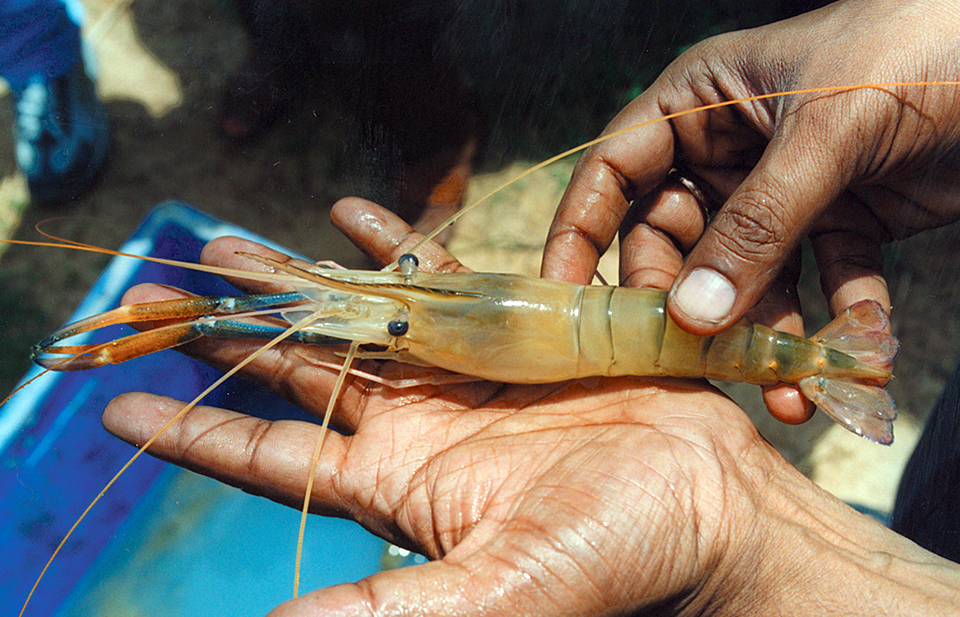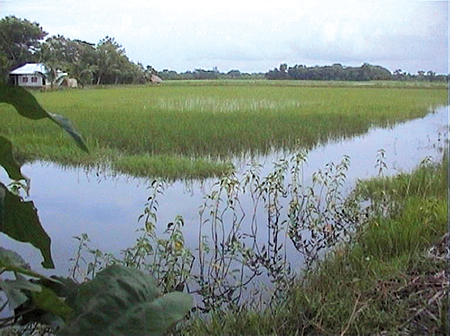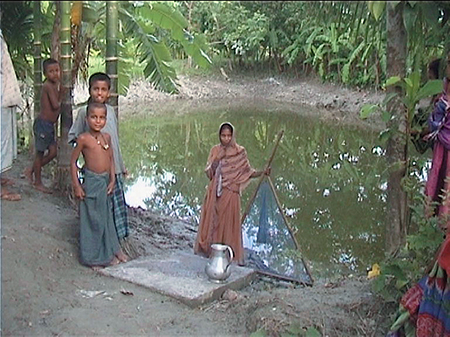Traceability requirements a big barrier for producers aiming to export

Bangladesh may be a small player in terms of global shrimp production, but for a country where more than 34 percent of the population lives in poverty and the illiteracy rate is 48 percent, producing and exporting shrimp provides an important source of foreign exchange. In Bangladesh, shrimp is the second-largest export earner, generating around U.S. $301 million annually.
Freshwater prawns
While black tiger shrimp (Penaeus monodon) are the major species exported from Bangladesh, giant freshwater prawns (Macrobrachium rosenbergii) now account for 28 percent of the export volume. Bangladesh exported approximately 12,000 tons of freshwater prawns in 2001-2002. Export sales of Macrobrachium during the period were U.S. $58 million.
Conditions are particularly favorable for the cultivation of Macrobrachium in many parts of Bangladesh, and more than 100,000 households depend on freshwater prawn farming. The average farm size is less than 0.3 ha.
The total area under cultivation is estimated at around 30,000 ha, compared to the 170,000 ha used for growing Penaeus monodon. However, Macrobrachium production is increasing by around 20 percent per year with the expansion of freshwater cultivation into new areas of low-lying flood plains.
Markets
The major markets for Bangladesh’s shrimp are the United States, which receives about 40 percent of exports, followed by the European Union (mainly the United Kingdom, which imports 14 percent of Bangladesh’s shrimp), and Japan (11 percent). For Macrobrachium, most of the demand comes from the United Kingdom, Netherlands, Belgium and France.
Bangladesh shrimp typically trades at around 10 percent less than product from competitor countries such as Thailand. Bangladesh also benefits from duty-free access to the European Union, unlike Thailand, whose shrimp receives a 10 percent tariff.
Small-scale integrated farms

Shrimp aquaculture has grown rapidly over the last 10 years and brought significant socioeconomic benefits to many poverty-stricken areas of Bangladesh. Thousands of rural households living on coastal flood plains have converted their paddy fields – known locally as “ghers” – into integrated farm systems with rice, fish, prawns, and vegetables. Their small-scale, low-input farming methods provide a supply of subsistence food for the household supplemented by a cash crop.
These farmers grow freshwater prawns in converted rice fields consisting of a trench and dikes around a central paddy section. Most of the farms are rain-fed. Hence, there is no water exchange, and since extensive methods are used, the sector has not experienced the effluent and sediment disposal problems affecting many other shrimp-producing countries.
Fish and prawns are stocked with the onset of the rains. A crop of “boro” rice is grown in the winter – and occasionally “amon” rice in the summer months – and vegetables are grown on the dikes. Harvesting starts in August and continues until December. Prawn sizes at harvest are usually 150 to 200 grams.
The most expensive input for farmers is animal fry, which represent 28 percent of total costs. Presently, most farmers rely on a supply of wild postlarvae due to an inadequate supply of hatchery seedstock, although more hatcheries are starting to produce postlarvae. Feed and labor are the other main costs associated with Macrobrachium culture. Yields for the average farm in Bangladesh are around 336 kilograms per hectare.
Increased income
Interventions to reduce stocking rates, improve fry nursing, use homemade feeds, and increase access to low-cost credit have made integrated farming more accessible to poor farmers, raised household incomes and boosted local economies.
Integrated gher technology significantly increases household incomes by reducing costs and increasing prawn output. Incomes are further enhanced and diversified by the introduction of fish culture and dike cultivation. The expanded availability and stability of income reduces the need for local high-cost credit and allows people to overcome many of the seasonal shortages of local food items.
Prospects for future

The future growth of the freshwater prawn sector in Bangladesh ultimately depends on the responsiveness of the industry to emerging trends in global markets. Increasing concerns over food safety, environmental sustainability, and human rights are driving global demands for greater traceability. This is potentially devastating for the Bangladesh shrimp industry, because its production is based around thousands of small-scale extensive farms, and the product is aggregated and traded at several levels before it reaches processing plants.
The costs of participating in traceability programs are potentially prohibitive for small-scale farms due to the economies of scale in establishing quality-assurance systems. Yet it is the very existence of this smallholder segment of the sector that counters those critics who claim that shrimp farming in developing countries is unsustainable and unethical.
The Bangladesh shrimp industry must identify and use its comparative advantages to become more competitive with other producing countries. One inherent advantage lies in the improving productivity of its low-input, extensive production system. Effective marketing is another positive.
In the current economic climate, where global shrimp prices are at an all-time low, there is little justification for shifting to semi-intensive methods. Well-planned, small-scale freshwater farming is environmentally sustainable and brings economic and social development to traditionally poor rural areas in Bangladesh.
The biggest competitive challenge is to develop a traceability system that facilitates and promotes smallholder participation so the majority of existing producers can apply for certification. One option is to offer certification to groups of producers so they can be certified as one production unit. The Shrimp Seal of Quality Organization is working closely with 15 NGO partners in southwest Bangladesh, where most of the farms are located, to develop cluster groups of farms and link them directly to processing plants via commission agents.
(Editor’s Note: This article was originally published in the October 2003 print edition of the Global Aquaculture Advocate.)
Now that you've finished reading the article ...
… we hope you’ll consider supporting our mission to document the evolution of the global aquaculture industry and share our vast network of contributors’ expansive knowledge every week.
By becoming a Global Seafood Alliance member, you’re ensuring that all of the pre-competitive work we do through member benefits, resources and events can continue. Individual membership costs just $50 a year. GSA individual and corporate members receive complimentary access to a series of GOAL virtual events beginning in April. Join now.
Not a GSA member? Join us.
Author
-
Debbie Williams
Shrimp Seal of Quality Program
House 47, Road 23, Banani
Dhaka, Bangladesh
Tagged With
Related Posts

Intelligence
Culture of giant freshwater prawns in China
Farming of giant freshwater prawns is very popular in China. The Yangtze River Delta region produces more than 60 percent of the country's output. Production increases have resulted from a novel system that involves greenhouses that allow ponds to be stocked ahead by two months.

Health & Welfare
Ammonia toxicity degrades animal health, growth
Ammonia nitrogen occurs in aquaculture systems as a waste product of protein metabolism by aquatic animals and degradation of organic matter, or in nitrogen fertilizers. Exposure can reduce growth and increase susceptibility to diseases in aquatic species.

Responsibility
Bangladesh study examines potential for prawn cage farming
While Bangladesh's prawn industry is based on pond culture, a feasibility study was conducted to establish prawn cage culture to benefit resource-poor fishers and landless people.

Responsibility
Coastal aquaculture in Bangladesh must adapt to climate change
Shrimp culture in coastal Bangladesh is threatened by climate change variables that include flooding, cyclones, drought, salinity changes and rising sea levels. Holistic planning can help reduce the impacts.


